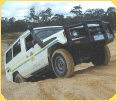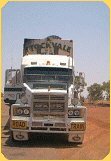 |
 |
|
|
|
||
|
Outback Info (Private Seiten) © seit 1999 Hairy Nosed Wombat
The Hairy-Nosed or Plains Wombat (Lasiorhinus latifrons) was adopted by the Government as the faunal emblem of South Australia on 27 August 1970. It is a marsupial mammal indigenous to Australia and totally protected in South Australia. The generic name, Lasiorhinus, means hairy-nosed and the specific name, latifrons, means broad-fronted. The Hairy-Nosed Wombat is a thick-set powerful mammal with a broad blunt head, small pointed ears, short muscular legs, strongly clawed feet and a rudimentary tail. It has soft grey-brown silky fur. Adults are up to 30cm high, 75 to 95cm long, and weigh between 18 and 32 kilos. The animal is adapted to life in semi-arid and arid zones and, apart from some small colonies in the south-east of Western Australia, is confined to South Australia. It is most abundant on Eyre Peninsula, the Gawler Ranges and the Nullarbor Plain. Smaller colonies occur on the west bank of the Murray River and on Yorke Peninsula. The Hairy-Nosed Wombat is essentially a plains dweller inhabiting many combinations of soils and vegetation, especially open woodlands and shrublands. It is a very powerful digger - only deterred by soft sand and unbroken sheet limestone - and excavates deep cool, humid burrows which are essential for survival in its hot, waterless environment. The wombat feeds exclusively on plant material which often is its only source of water. A single young measuring only 2cm in length, is born between September and January and remains entirely confined to its mother's backwardly directed pouch for the next five months. After this, the young ventures out for increasing periods, continuing to suckle while accustoming itself to adult food. Young wombats continue to live in their mothers' burrows for a further two years before being driven out. The Faunal Emblem can be reproduced without seeking permission from the Protocol Office.
|
Schatzsuche in Down Under / Fossicking
|
||||||||||||||||||||||||||||||||||||||||||||||||||||||||||||||||||||||||||||||||||||||||||||||||||||||||||||||||||||||||||||||||||||||||||||||||||||||||||||||||||||||||||||||||||||||||||||||||||||||||||||||||||||||||||||||||||||||||||||||||||||||||||||||||||||||||||
Australien-Kanal.de © seit 1999, Fossicking.de © seit 1999




